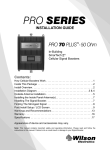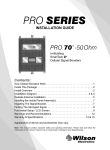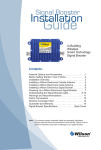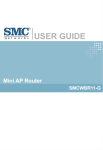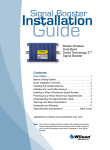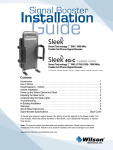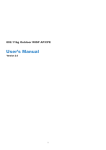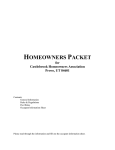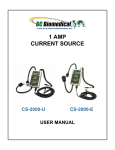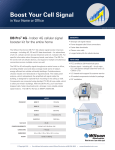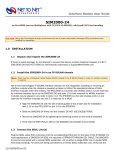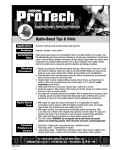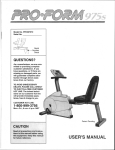Download Wilson RF Signal Detector USER GUIDE
Transcript
User’s RF Signal Detector Model #2E7501 Contents: Purpose. . . . . . . . . . . . . . . . . . . . . . . . . . . . . . . . . . . . . . 1 Powering Up the Detector. . . . . . . . . . . . . . . . . . . . . . . . 2 Understanding the LCD Screen. . . . . . . . . . . . . . . . . . . .3 Guarantee & Warranty. . . . . . . . . . . . . . . . . . . . . . . . . . . 6 Specifications . . . . . . . . . . . . . . . . . . . . . . . . . Back Cover Appearance of device and accessories may vary. Note: This manual contains important safety and operating information. Please read and follow the instructions in this manual. Failure to do so could be hazardous and result in damage to your Signal Detector. Purpose The purpose of the RF Signal Detector is to assist the installation of a Wilson Electronics Signal Booster, specifically for: • Mapping the frequency environment • Pointing directional antennas • Maximizing Wilson Electronics Signal Booster coverage Recommended Outside Antenna Any Outside Antenna may be used. The recommended antenna for installing a Wilson Signal Booster is the antenna the Signal Booster came with. Directional antennas will help the installer determine the location of a signal-of-interest or interferer. For general frequency mapping, the 304411 is recommended because it is both directional and has wide bandwidth. This will allow the installer to use the RF Signal Detector without ever having to change antennas. Inside this Package Rubber Antenna for indoor frequency mapping (301144 ) Velcro Stickers Power Supply (859912) Battery Pack (859996) RF Signal Detector (867501) N-Male to N-Male Connector (971149) TNC-Female to N-Male Connector (971148) Optional Accessory Kit: (308410) A. Wide-Band Panel Antenna 700-2700MHz (304411) B. Pole Mount Assembly (901117) C. 2’ Extension Cable RG58, N-Male to N-Male (951134) A. B. C. Appearance of device and accessories may vary. 1 To purchase, contact Wilson Electronics Sales Department at: 800-204-4104 Contact Wilson Electronics Technical Support Team with any questions at 866-294-1660 or email: [email protected]. Mon.-Fri. Hours: 7 am to 6 pm MST. Frequency Mapping Finding Strongest Outdoor Signal Cell Tower RF Signal Detector Wide Band Directional Antenna Checking Inside Coverage Area Inside Panel Antenna Power 872.75 1.5 -98 RF SIGNAL DETECTOR BAND Select BW Select CH Select RF Signal Detector Check inside coverage before & after installation of Signal Booster system. Powering Up the RF Signal Detector 1. Ensure that the Outside Antenna cable or Rubber Antenna is connected to the RF Signal Detector and the connection is tight before powering up the RF Signal Detector. 2. Plug the AC power supply or battery pack into the RF Signal Detector input marked “6V DC” (carefully, to avoid damaging the center pin). Plug into surge protected AC Power Strip. NOTE: Utilize the velcro included in this kit to secure Battery Pack to bottom side of Signal Detector. Contact Wilson Electronics Technical Support Team with any questions at 866-294-1660 or email: [email protected]. Mon.-Fri. Hours: 7 am to 6 pm MST. 2 Power 3. If the RF Signal Detector does not have a green light or if you questions, please contact Wilson Electronics Technical Support Team at 866-294-1660 or email [email protected]. Technical Support hours are Mon.- Fri. 7 872.75 am to 6 pm MST. 1.5 -98 Understanding the LCD Screen BAND Select Figure 1 1. The Downlink Center Frequency is the top number on the screen. Units are MHz. BW Select CH Select Power 2. The Pass Bandwidth is the bottom left number on the screen. Units are MHz. Power Pass Bandwidth 3. The Detected Cellular Downlink 872.75 Signal Level is the bottom right 1.5 -98 number on the screen. Units are dBm. 872.75 1.5 -98 Downlink Center Frequency Detected Cellular Downlink Signal Power BAND BW Select Select 4. The BAND Select button 872.75 will select between downlink 1.5 -98 bands. Note: For a list of band options see tables on page 4. BAND Select BW Select CH Select CH Select Power 872.75 5. The BW (bandwidth) Select button toggles between 1.5 MHz and 10 1.5 -98 MHz pass bandwidth. Note: For filter characteristics see tables on page 4. BAND Select BAND Select BW Select BW Select CH Select CH Select 6. The CH (Channel) Select button will step to the next channel. Steps are in 1.5 MHz increments for 1.5 MHz BW. Steps are typically 5 MHz increments for 10 MHz BW. Note: For a list of channel options see tables on page 4. 7. Any button may be held down to step more quickly. 8. If the RF Signal Detector is operating normally the LCD Screen will appear similar to Figure 1. 3 Contact Wilson Electronics Technical Support Team with any questions at 866-294-1660 or email: [email protected]. Mon.-Fri. Hours: 7 am to 6 pm MST. To Find Your Wireless Providers Licensed Broadcast Frequencies: 1. Go to http://wireless2.fcc.gov/UlsApp/UlsSearch/searchLicense.jsp 2. Look for “Specialized search” on right side of screen. 3. Click on “Geographic.” 4. Enter your region. 5. Enter a specific frequency range to narrow the search results. As the signal detector indicates the downlink frequency, below are the recommended frequency ranges to search for each band: - 700 MHz - Search “728-757” - 850 MHz - Search “869-894” - 1900 MHz - Search “1930-1990” - AWS - Search “2110-2155” 6. Click Search. 7. On the Search Results page, click on the wireless provider of interest NOTE: Most will show the wireless provider’s name. If it does not show the wireless provider’s name, then select the “Call Sign/Lease ID” and then look at “Contact” for the wireless provider. 8. Check that the license is “Active” under “Status.” 9. Click “(View Frequencies)” or look at “Associated Frequencies” and “Channel Block.” 10. Click on the “Market” tab and look at the “Spectrum and Market Area” to verify the exact frequency that your provider is operating on in your particular county or counties. Contact Wilson Electronics Technical Support Team with any questions at 866-294-1660 or email: [email protected]. Mon.-Fri. Hours: 7 am to 6 pm MST. 4 Available Downlink Bands/Channels Downlink Center Frequency Highest Center Frequency (MHz) Downlink Band Pass Bandwidth (MHz) Lowest Center Frequency (MHz) 850 MHz (Cellular) 1.5 869.75 895.25 10 874.5 896.5 1.5 1930.75 1989.25 10 1935 1985 1.5 2110.75 2154.25 10 2115 2150 1.5 728.75 755.75 10 733 751 1900 MHz (PCS) 1700/2100 MHz (AWS) 700 MHz (Band 12 & 13) Filter Characteristics, Typical Pass Bandwidth (MHz) -3dB BW (MHz) -40dB BW (MHz) -45dB BW (MHz) 1.5 1.5 4.45 4.65 10 9.9 12.9 13.2 About Wilson Electronics Wilson Electronics, Inc. has been a leader in the wireless communications industry for over 40 years. The company designs and manufactures Signal Boosters, Antennas and related components that significantly improve cellular phone signal reception and transmission in a wide variety of applications, both mobile (marine, RV, vehicles) and in-building (home, office, M2M). With extensive experience in antenna and Signal Booster research and design, the company’s engineering team uses a state-of-the-art testing laboratory, including an anechoic chamber and network analyzers, to fine-tune antenna designs and performance. For its Signal Boosters, Wilson Electronics uses a double RF electrically shielded enclosure and cell tower simulators for compliance testing. All products are engineered and assembled in the company’s 55,000-square-foot headquarters in St. George, Utah. Wilson Electronics has product dealers in all 50 states as well as in countries around the world. 5 Contact Wilson Electronics Technical Support Team with any questions at 866-294-1660 or email: [email protected]. Mon.-Fri. Hours: 7 am to 6 pm MST. 30-Day Money-Back Guarantee All Wilson Electronics products are protected by Wilson Electronics 30-day money-back guarantee. If for any reason the performance of any product is not acceptable, simply return the product directly to the reseller with a dated proof of purchase. 1-Year Warranty Wilson Electronics Signal Boosters are warranted for one (1) year against defects in workmanship and/or materials. Warranty cases may be resolved by returning the product directly to the reseller with a dated proof of purchase. Signal Boosters may also be returned directly to the manufacturer at the consumer’s expense, with a dated proof of purchase and a Returned Material Authorization (RMA) number supplied by Wilson Electronics. Wilson Electronics shall, at its option, either repair or replace the product. Wilson Electronics will pay for delivery of the repaired or replaced product back to the original consumer if located within the continental U.S. This warranty does not apply to any Signal Booster determined by Wilson Electronics to have been subjected to misuse, abuse, neglect, or mishandling that alters or damages physical or electronic properties. Failure to use a surge protected AC Power Strip with at least a 1000 Joule rating will void your warranty. RMA numbers may be obtained by contacting Technical Support at 866-294-1660. Disclaimer : The information provided by Wilson Electronics, Inc. is believed to be complete and accurate. However, no responsibility is assumed by Wilson Electronics, Inc. for any business or personal losses arising from its use, or for any infringements of patents or other rights of third parties that may result from its use. Copyright © 2012 Wilson Electronics, Inc. All rights reserved. U.S. Patent Nos. – 7,729,669; 7,486,929 Contact Wilson Electronics Technical Support Team with any questions at 866-294-1660 or email: [email protected]. Mon.-Fri. Hours: 7 am to 6 pm MST. 6 RF Signal Detector Specifications RF Signal Detector Specifications Model Number 2E7501 Antenna connector N-Type Antenna impedance 50 ohms Dimensions Weight 5.7 x 4.2 x 1.5 inch (14.0 x 10.8 x 3.9 cm) 1.24 lbs Maximum detectable in-band signal (dBm) -38 Minimum detectable in-band signal with 1.5MHz BW (dBm) -110 Minimum detectable in-band signal with 10MHz BW (dBm) -105 Maximum recommended RF input (dBm) Power Requirements -38 110-240 V AC, 50-60 Hz, 4.2W or 6V DC, 700mA 3301 East Deseret Drive, St. George, UT 84790 For additional Technical Support visit www.WilsonElectronics.com or email: [email protected] Phone: 866-294-1660 Local: 435-673-5021 Fax: 435-656-2432 www.twitter.com/WilsonCellular www.facebook.com/WilsonCellular 111081_RF Signal Detector_Rev05_07.25.12










